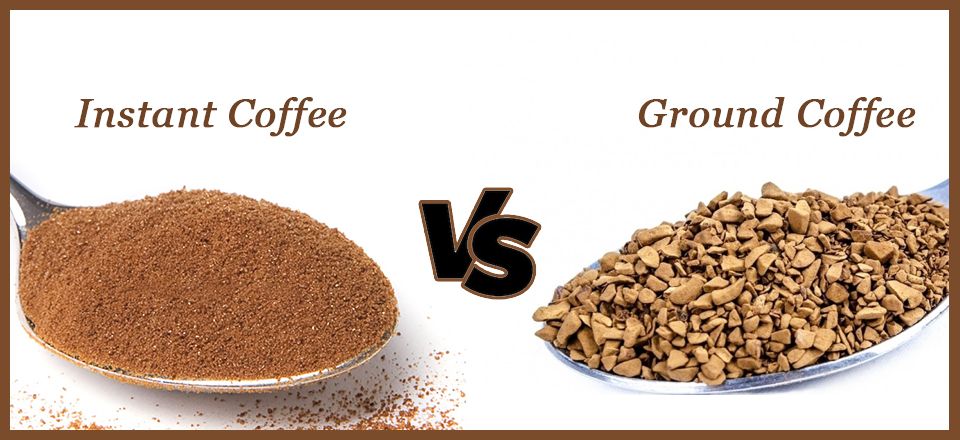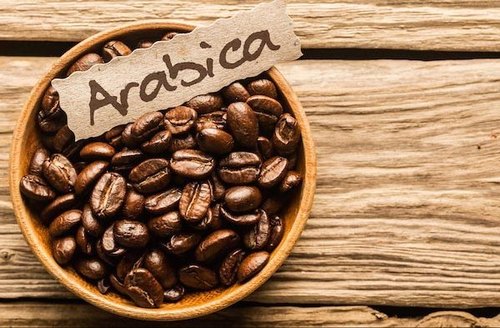Distinction Between Instant & Regular Coffee?

Over the years, instant coffee has earned a poor rap. Most of us had a grandmother who kept a massive tin of instant coffee on their kitchen counter. However, there are many more coffee snobs today than there were decades ago who would not even attempt instant coffee. What is the difference between instant and traditional coffee, in any case?
Here’s what I found out after doing some research:
The difference between instant coffee and regular coffee is that instant coffee is ready to drink immediately after adding hot water. Still, conventional coffee requires brewing, which can take several minutes. Instant coffee, on the other hand, has been brewed into a concentrate and dried.
Freeze-drying or hot air-drying are the two options for drying. Compared to the Arabica bean used in higher-end brands, many instant coffees employ the inferior Robusta coffee bean.
Many people think instant coffee isn’t as good as regular ground and brewed coffee. I’d absolutely be one of them. It may not have the same depth of flavor or require the same skill level as brewed coffee. However, modern instant coffee brands can still be found in most homes throughout the world.
If you’re in a hurry, several types of instant coffee can still brew an excellent cup of coffee. It’s also perfect for camping or road trips where a Starbucks isn’t readily available. But first, let’s look at the differences in greater detail. We’ll look into why those enormous tins at Grandma’s house taste so horrible and which current brands are genuinely flavorful.
Let’s take a sip together!
Is instant coffee comparable to traditional coffee in terms of taste?
Even if you use a high-quality instant coffee, it will not taste as terrific as freshly prepared regular coffee. On the other hand, Instant coffee is lower in caffeine. It has the same amount of beneficial antioxidants as any traditional coffee.
Instant coffee, believe it or not, is highly popular in many parts of the world. In fact, nearly half of the world’s population feels that instant coffee is preferable to traditional brews!
Many people who prefer instant coffee are from Asia, Australia, and New Zealand (as well as Mexico, the United Kingdom, and a few countries in South America and Africa). In fact, the vast majority of countries that chose tea as their hot beverage of choice also favor instant coffee.
Overall, it is less expensive, quicker, and easier to prepare, all of which are vital considerations when rushing out the door for work or making yourself a mid-afternoon cup at your desk.
Despite its popularity in the east, many people in the west, particularly those with refined coffee palates, still prefer the fresh stuff. According to a Washington Post report, the United States is the only country where instant coffee is not widely consumed.
There are several situations where instant coffee may be more beneficial in terms of health.
Because of its concentrated form, some varieties may have higher levels of antioxidants. It could also be lower in caffeine, which isn’t always a good thing when you’re in need of a boost. However, for people wanting to reduce their caffeine use, this could be a favorable factor.
Those with sophisticated coffee palates will be able to tell the difference between regular and instant coffee almost instantaneously when it comes to flavor. This is due to the fact that freshly brewed coffee retains all of its vital oils and chemical components, giving it a richer flavor. This, paired with the greater flavor variety found in fresh coffee, results in a more nuanced flavor than most instant variants.
Is it possible to make instant coffee from traditional coffee?
When you add hot water to regular ground coffee, it does not transform into instant coffee. Even if the ground is on a delicate setting on a grinder, the coffee will be excessively coarse, and the grinds will float in the brewed coffee.
If you don’t have access to a coffee machine, finely ground the coffee, add hot water, soak for a few minutes, and then drain through a paper filter or cheesecloth. Some instant coffee mixes appear to be identical to ordinary coffee grounds at first glance. They are not, however, the same.
However, you can’t substitute instant coffee for ground coffee and vice versa.
You can’t expect coffee grounds to dissolve in hot water the same way instant coffee does. You can still make a good cup of coffee if you have the correct tools.
However, if you don’t use a filter, you’ll end up with gritty coffee.
Instant coffee is famous due to its ease of use. You don’t have to wait for an entire pot of coffee to brew to make your morning cup of coffee. You might not realize that even if all you have are coffee grounds, you can make a fantastic cup of coffee in minutes.
The only thing you’ll need is a French press.
Of course, a Keurig coffee maker can create a cup of coffee in a matter of minutes; in fact, it is faster than a French press. On the other hand, a French press is the way to go if you want a smooth and pure coffee flavor.
What exactly is instant coffee?

Regular coffee is brewed at a high concentration with water and then freeze-dried or air-dried to produce instant coffee. The final product is coarsely ground and packed.
You might be wondering what dried coffee extract is, mainly because we’ve already established that ground coffee and instant coffee are not the same things. To prepare instant coffee, begin by similarly brewing coffee to how you would brew ordinary coffee, but in a much more concentrated “dose.”
The water is removed from the coffee after it has been brewed. Leaving dry pieces or powder that will dissolve when water is added.
One of two methods is used to extract water from the extract and transform it into instant coffee.
Spray-drying involves spraying concentrated coffee extract into hot air to quickly dry the droplets and turn them into a powder or small granules.
Freeze-drying involves freezing coffee extract and cutting it into minute pieces, which are subsequently dried at a low temperature in a vacuum-sealed container.
Both of these processes help to preserve the original coffee’s quality, fragrance, and flavor, so you can still make a decent cup of coffee by merely adding hot water.
What is it about instant coffee that makes it so wrong?
Many brands of instant coffee employ the inferior Robusto coffee bean rather than Arabica beans, resulting in a weaker flavor. However, the process of manufacturing instant coffee increases the amount of acrylamide in it, a chemical that has been linked to health problems in studies.
Acrylamide is a chemical that can be found in a variety of industrial processes.
This covers paper, dyes, and plastics manufacturing. It’s also made when coffee is brewed, and it may be in foods like potatoes (fries, chips, etc.), canned black olives, and prune juice.
Though further research is needed, it is thought that consuming too much of this chemical can increase your risk of certain malignancies and damage your neurological system. While it has not been established that drinking coffee increases your risk of cancer, you should be cautious of overexposure to this chemical. If you consume a lot of it in a day or if you only drink instant coffee.
Instant coffee contains up to twice as much acrylamide as regular coffee due to its high concentration. Again, nothing to get too worked up about, but something to keep in mind. Naturally, even while regular coffee offers health benefits, it also has drawbacks. Non-organically cultivated coffee beans have been exposed to pesticides and herbicides because they are a crop.
Are Arabica or Robusta coffee beans used to make instant coffee?

Robusta beans are used in the majority of instant coffees. Robusta is a lower-cost alternative to the more expensive Arabica bean. As a result, brands that do utilize Arabica boldly declare it on their labels.
Apart from acrylamide, one of the main reasons why instant coffee tastes awful is the inferior bean used to create it. Arabica beans or Robusta beans are used to make coffee.
Arabica beans are far superior to other types of beans. So let’s get more into that in this section.
Many companies switched to Robusta beans as a result of the 2011 Arabica shortage. So, while instant coffee sales in the United States have remained relatively stable, Robusta sales have surged by 7% as a result of the shortage.
Which instant coffee is the finest to buy?

For those seeking a new instant coffee to try, here are a few brands and blends to consider:
Waka Coffee is an Amazon’s Choice product with much positive feedback. Medium or mild roast, decaf or regular
Starbucks Via (hot and iced versions) — Starbucks practically launched the gourmet instant coffee fad with these long, skinny individual packets. Mount Hagen Organic Fairtrade Coffee — Amazon’s Choice product with hundreds of beautiful ratings – is my go-to when camping. This is certainly something you’ve seen on the shelves at Whole Foods.
Nescafe - I’m sure they make some awful ones as well. However, this Nescafe is made entirely of Arabica beans and is an Amazon’s Choice product with excellent reviews.
Medaglia D’Oro Instant Espresso - Another Amazon’s Choice product with excellent customer feedback. Although most of their products are 100 percent Arabica, I’m not sure about this one because it doesn’t mention so on the label.
Café Altura Fair Trade Organic Coffee: Like Mount Hagen, Café Altura combines 100% Arabica beans, fair trade, and organically farmed into an instant coffee that is unbeatable! It’s also an Amazon’s Choice item with much positive feedback.
Have I answered all of your questions about the difference between instant and traditional coffee?
I hope this clarifies the distinction between instant and traditional coffee for you.
There is nothing wrong with instant coffee for individuals who want a fast cup of coffee in the morning or midday. You can save money by not going to Starbucks and instead of making it with only hot water almost anywhere.
On the other hand, fresh coffee is the way to go if you want more flavor, depth, and variety.











